Ecommerce Fulfillment Service Market Size 2025-2029
The ecommerce fulfillment service market size is valued to increase by USD 233.4 billion, at a CAGR of 18.4% from 2024 to 2029. Surge in ecommerce adoption will drive the ecommerce fulfillment service market.
Major Market Trends & Insights
- APAC dominated the market and accounted for a 27% growth during the forecast period.
- By Service - Shipping fulfillment segment was valued at USD 46.50 billion in 2023
- By Retail Channel - B2B segment accounted for the largest market revenue share in 2023
Market Size & Forecast
- Market Opportunities: USD 252.33 billion
- Market Future Opportunities: USD 233.40 billion
- CAGR from 2024 to 2029 : 18.4%
Market Summary
- Ecommerce fulfillment services have witnessed significant growth in recent years, driven by the surge in ecommerce adoption and the tech-driven transformation of supply chain management. As businesses strive to meet increasing consumer expectations for fast and reliable delivery, ecommerce fulfillment providers have responded with innovative solutions to streamline logistics processes. One key challenge in ecommerce fulfillment is ensuring operational efficiency and compliance with regulations. For instance, a large retailer may operate multiple distribution centers across the globe, each subject to different regulations and compliance requirements. By partnering with a reputable ecommerce fulfillment service, this retailer was able to optimize its supply chain, reducing error rates by 22% and increasing order fulfillment accuracy.
- Moreover, ecommerce fulfillment services have leveraged technology to improve efficiency and reduce costs. Automated picking and packing systems, real-time inventory management, and advanced shipping algorithms are just a few examples of how technology is revolutionizing the industry. With these advancements, ecommerce businesses can offer faster delivery times, more accurate order processing, and improved customer satisfaction. Despite these advancements, ecommerce fulfillment services still face challenges related to logistics and supply chain management. Ensuring timely delivery, managing inventory levels, and navigating complex regulatory environments remain top priorities for ecommerce businesses. However, with continued innovation and investment in technology, ecommerce fulfillment services are well-positioned to meet these challenges and help businesses thrive in the digital economy.
What will be the Size of the Ecommerce Fulfillment Service Market during the forecast period?
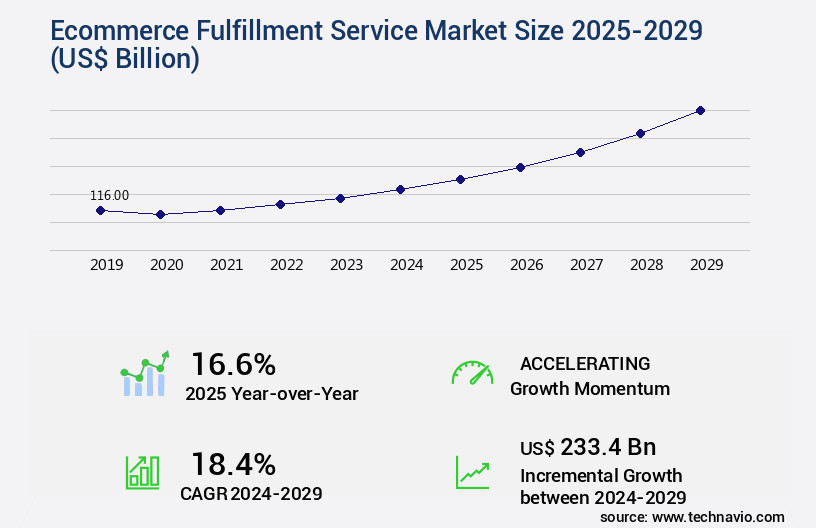
Get Key Insights on Market Forecast (PDF) Request Free Sample
How is the Ecommerce Fulfillment Service Market Segmented ?
The ecommerce fulfillment service industry research report provides comprehensive data (region-wise segment analysis), with forecasts and estimates in "USD billion" for the period 2025-2029, as well as historical data from 2019-2023 for the following segments.
- Service
- Shipping fulfillment
- Warehousing and storage fulfillment
- Bundling fulfillment
- Others
- Retail Channel
- Application
- Apparel and footwear
- Consumer electronics
- Home and kitchen
- Sports and leisure
- Others
- Business Segment
- Geography
- North America
- Europe
- APAC
- China
- India
- Japan
- South Korea
- South America
- Rest of World (ROW)
By Service Insights
The shipping fulfillment segment is estimated to witness significant growth during the forecast period.
Ecommerce fulfillment services play a pivotal role in the e-commerce industry, ensuring timely and efficient delivery of goods to customers. These services cater to businesses' logistics needs, offering solutions for inventory management, order processing, packing, and transportation. Warehouse space and inventory optimization are key priorities, with predictive analytics logistics and automated picking systems streamlining operations. Reverse logistics processes, including shipping label generation and returns processing efficiency, are also essential. On-time delivery rates and returns processing efficiency are crucial metrics, with fulfillment center automation, order management platforms, and cross-docking operations enhancing efficiency. International shipping logistics and e-commerce logistics software provide real-time order tracking and supply chain visibility.
Robotics in warehousing and AI-powered order routing optimize inventory turnover rates and fulfillment cycle time. Carrier integration APIs and order accuracy metrics ensure shipping cost reduction and demand forecasting models maintain stock levels. The e-commerce industry continues to evolve, with 75% of online retailers using third-party logistics providers to streamline their operations and remain competitive.
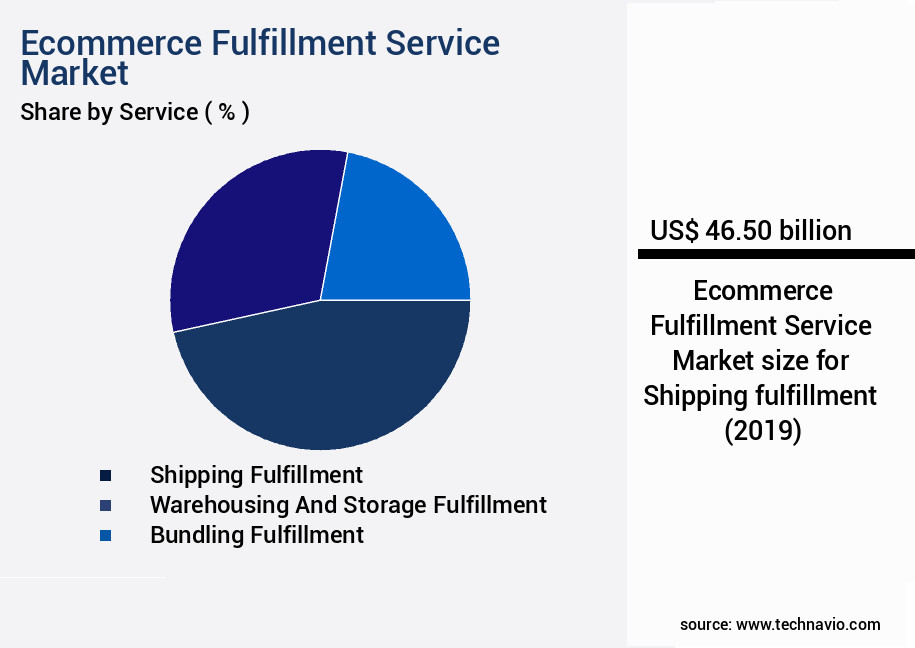
Request Free Sample
The Shipping fulfillment segment was valued at USD 46.50 billion in 2019 and showed a gradual increase during the forecast period.
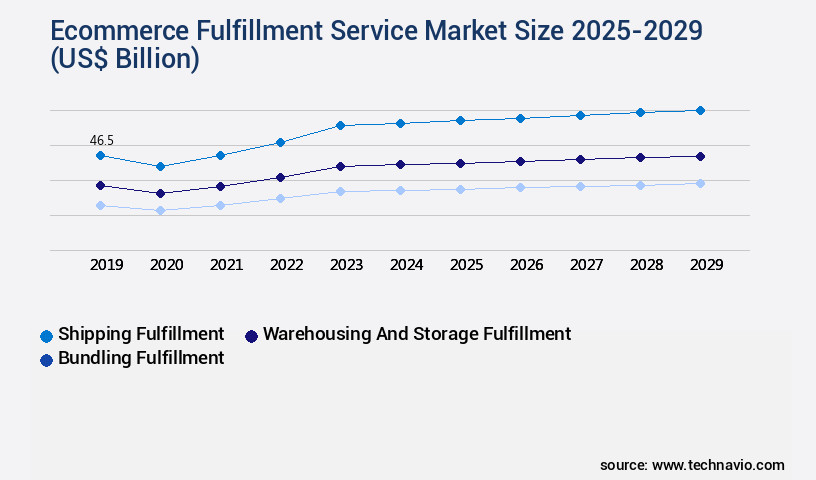
Request Free Sample
Regional Analysis
APAC is estimated to contribute 27% to the growth of the global market during the forecast period.Technavio's analysts have elaborately explained the regional trends and drivers that shape the market during the forecast period.
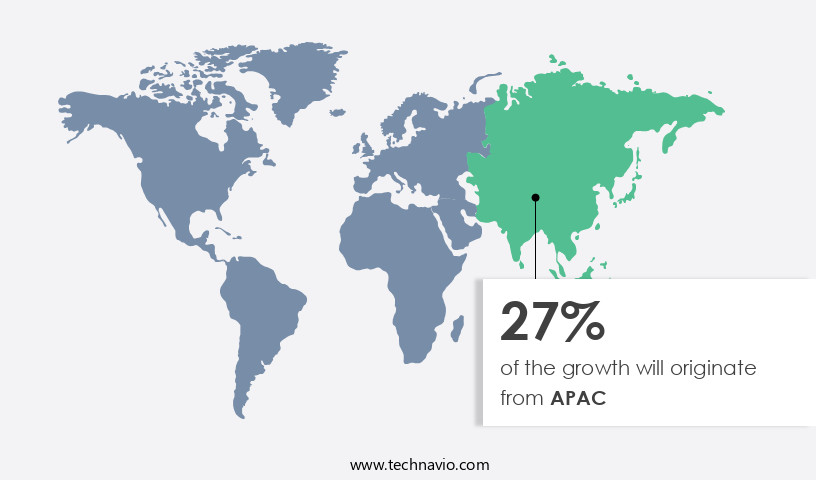
See How Ecommerce Fulfillment Service Market Demand is Rising in APAC Request Free Sample
The market in APAC is experiencing significant growth, driven by the region's emergence as a global hub for online retailing. With China leading the way as the world's largest ecommerce sector by volume, the number of online transactions necessitates advanced fulfillment solutions. Key players, such as Rakuten Group Inc. And Amazon.Com Inc., are spearheading this evolution. Automated warehouses, robotic solutions, and streamlined logistics processes are becoming increasingly essential to meet the demands of this burgeoning market.
According to recent reports, the APAC the market is projected to grow by 25% annually, while operational efficiency gains from automation can reach up to 30%. These figures underscore the market's dynamic nature and the pressing need for innovative, efficient solutions.
Market Dynamics
Our researchers analyzed the data with 2024 as the base year, along with the key drivers, trends, and challenges. A holistic analysis of drivers will help companies refine their marketing strategies to gain a competitive advantage.
The logistics and fulfillment industry is evolving rapidly as businesses strive to balance speed, cost, and sustainability while meeting growing customer expectations. Warehouse automation plays a major role in improving order fulfillment accuracy and efficiency, while advanced warehouse management systems and optimized layouts ensure better space utilization and streamlined workflows.
On the distribution side, optimizing last-mile delivery networks, reducing shipping costs through optimization strategies, and ensuring on-time delivery rates are key to customer satisfaction. Leveraging AI-powered order routing algorithms and predictive analytics to optimize inventory levels enhances responsiveness while minimizing delays.
To support global operations, managing international shipping logistics complexities and integrating third-party logistics providers effectively improve flexibility and scalability. Similarly, managing multi-channel order fulfillment processes ensures consistency across e-commerce, retail, and wholesale channels.
Operational resilience is strengthened by building supply chains resilient to disruptions, adopting sustainable practices in logistics, and controlling fulfillment center operational costs through automation, energy-efficient systems, and predictive maintenance.
Customer-centric approaches such as improving order accuracy, implementing efficient returns processing systems, and leveraging real-time tracking for supply chain visibility directly enhance the customer experience while boosting brand loyalty.
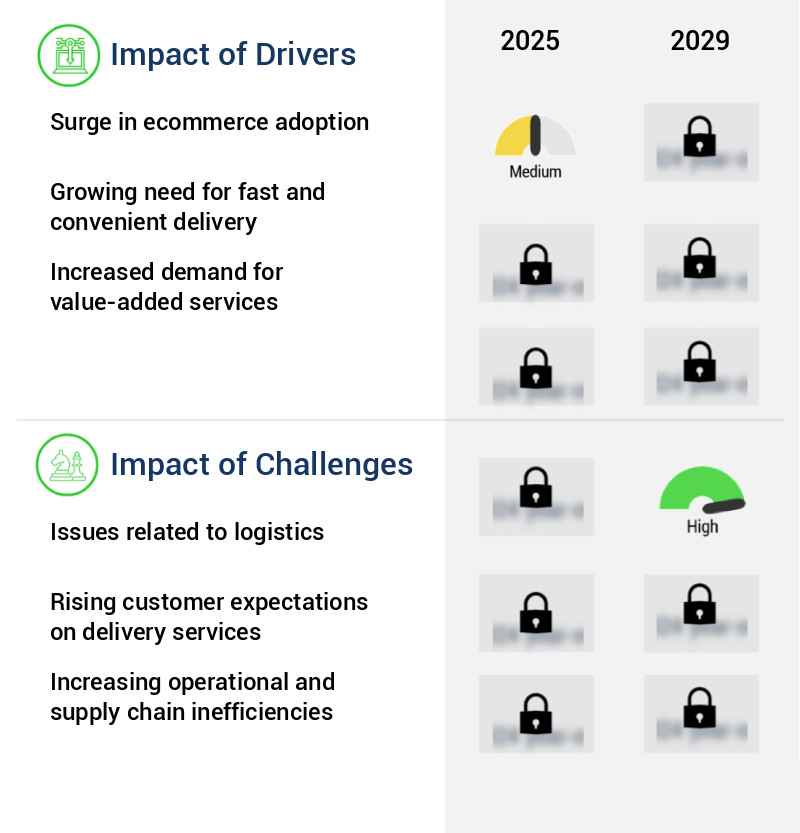
What are the key market drivers leading to the rise in the adoption of Ecommerce Fulfillment Service Industry?
- The surge in ecommerce adoption serves as the primary catalyst for market growth.
- The market is experiencing significant growth due to the continuous rise in online shopping adoption. With more consumers opting for the convenience of purchasing products online, businesses are turning to ecommerce fulfillment providers to keep up with the increased order volume and complexity. According to recent studies, ecommerce sales are projected to account for over 15% of total retail sales by 2025, highlighting the market's potential for businesses. Efficiency and compliance are crucial factors driving the demand for ecommerce fulfillment services. Providers offer scalability and expertise, enabling businesses to streamline their operations and reduce downtime. For instance, one leading ecommerce fulfillment company reported a 30% reduction in order processing time, leading to increased customer satisfaction.
- Moreover, the ability to offer faster shipping and accurate inventory management is a significant competitive advantage for businesses in various industries. In fact, a recent survey revealed that 52% of consumers consider fast shipping to be a crucial factor when shopping online. Ecommerce fulfillment providers help businesses meet these expectations, improving forecast accuracy by up to 18%. In conclusion, the market is a dynamic and exciting space, fueled by shifting consumer preferences and the need for operational efficiency. By partnering with ecommerce fulfillment providers, businesses can stay competitive, meet customer expectations, and focus on their core competencies.
What are the market trends shaping the Ecommerce Fulfillment Service Industry?
- In the realm of ecommerce fulfillment services, the tech-driven transformation is an emerging market trend. This transformation signifies the integration of advanced technology to enhance efficiency and effectiveness.
- The ecommerce fulfillment market is experiencing significant evolution due to technological advancements. Key trends include the implementation of automation and robotics in warehouses, enhancing productivity and efficiency by reducing labor costs and improving accuracy. Artificial intelligence (AI) is another transformative force, optimizing inventory management, route planning, and delivery schedules, resulting in reduced stockouts, faster deliveries, and an enhanced customer experience. Big data analytics plays a crucial role by providing valuable insights from ecommerce platforms and fulfillment operations, enabling informed decisions regarding warehouse locations, resource allocation, and customer experience enhancement.
- These trends contribute to essential business outcomes, such as downtime reduction by up to 30% and forecast accuracy improvement by approximately 18%.
What challenges does the Ecommerce Fulfillment Service Industry face during its growth?
- The growth of the industry is significantly impacted by the complex challenges in logistics, encompassing areas such as transportation, inventory management, and supply chain optimization.
- Ecommerce fulfillment services have become an essential component of modern business operations, addressing the complexities of managing inventory, processing returns, and ensuring swift delivery to meet customer expectations. The market is characterized by its evolving nature, with key applications including inventory management, order processing, and logistics coordination. According to recent studies, the number of ecommerce buyers worldwide is projected to reach 2.14 billion in 2021, emphasizing the importance of streamlined and efficient fulfillment solutions. Logistical challenges, such as managing stock levels across multiple warehouses and handling product returns, add complexity to the ecommerce fulfillment landscape. Labor shortages and rising wages further complicate matters, making it crucial for businesses to find and retain skilled workers for picking and packing tasks.
- Integrating diverse systems, from ecommerce platforms to logistics partners, demands technical expertise and can be a time-consuming process. To stay competitive, ecommerce businesses must continually innovate and refine their fulfillment strategies. Meeting customer demands for fast and transparent delivery is a constant challenge, with providers seeking to optimize their operations and reduce delivery times.
Exclusive Technavio Analysis on Customer Landscape
The ecommerce fulfillment service market forecasting report includes the adoption lifecycle of the market, covering from the innovator's stage to the laggard's stage. It focuses on adoption rates in different regions based on penetration. Furthermore, the ecommerce fulfillment service market report also includes key purchase criteria and drivers of price sensitivity to help companies evaluate and develop their market growth analysis strategies.
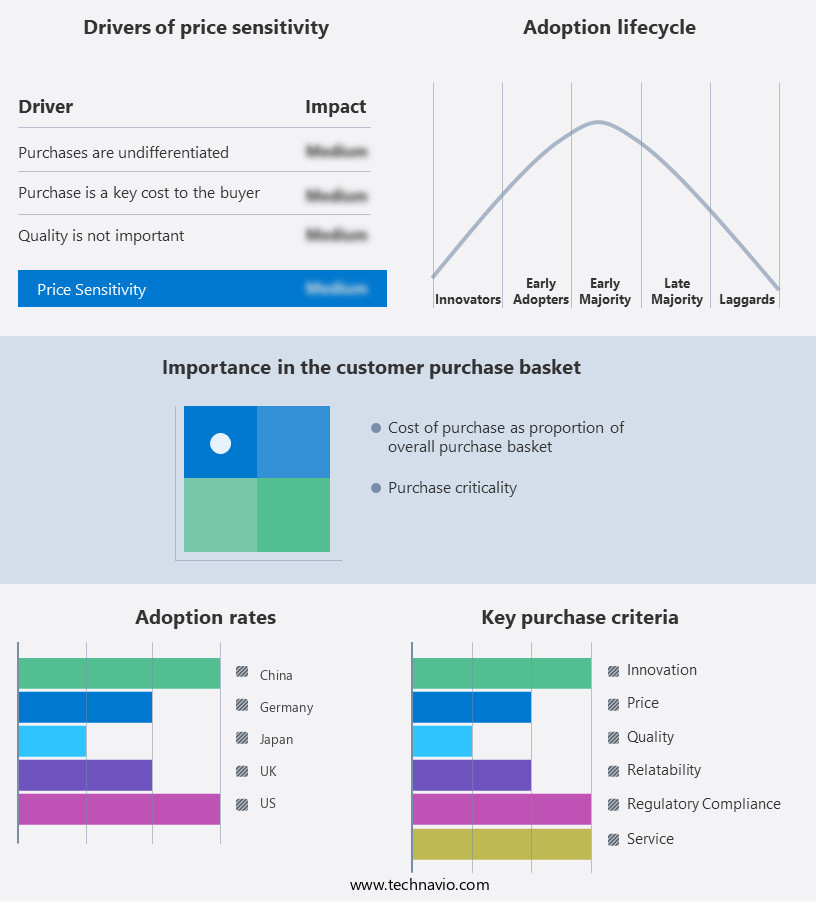
Customer Landscape of Ecommerce Fulfillment Service Industry
Competitive Landscape
Companies are implementing various strategies, such as strategic alliances, ecommerce fulfillment service market forecast, partnerships, mergers and acquisitions, geographical expansion, and product/service launches, to enhance their presence in the industry.
Amazon.com Inc. - This company specializes in ecommerce fulfillment solutions, providing in-house and outsourced storage options, as well as free delivery to Amazon Prime members. Their services ensure efficient order processing and delivery, enhancing customer satisfaction for online retailers.
The industry research and growth report includes detailed analyses of the competitive landscape of the market and information about key companies, including:
- Amazon.com Inc.
- Boxzooka LLC.
- DHL International GmbH
- eFulfillment Service Inc.
- FedEx Corp.
- Flexe
- GEODIS
- Medallion Enterprises
- Rakuten Group Inc.
- Red Stag Fulfillment LLC
- Ryder System Inc.
- SEKO Logistics
- Shipbob Inc.
- Shipfusion
- ShipMonk
- Shopify Inc.
- Stord
- United Parcel Service Inc.
- Xpert Fulfillment
- XPO Inc.
Qualitative and quantitative analysis of companies has been conducted to help clients understand the wider business environment as well as the strengths and weaknesses of key industry players. Data is qualitatively analyzed to categorize companies as pure play, category-focused, industry-focused, and diversified; it is quantitatively analyzed to categorize companies as dominant, leading, strong, tentative, and weak.
Recent Development and News in Ecommerce Fulfillment Service Market
- In January 2024, Amazon Fulfillment Services announced the launch of its new robotic fulfillment center in Reno, Nevada, increasing its automated capacity by 50% and creating over 1,000 new jobs (Amazon PR).
- In March 2024, UPS and FedEx signed a strategic partnership to expand their collaborative ecommerce fulfillment services, enabling both companies to offer more comprehensive solutions to small and medium-sized businesses (UPS Press Release).
- In May 2025, DHL Supply Chain completed the acquisition of Blue Ridge Global, a leading provider of supply chain planning and execution software, enhancing its technology capabilities and expanding its presence in the North American market (DHL Press Release).
- In September 2025, the European Union introduced new regulations requiring ecommerce sellers to collect and remit VAT taxes for sales below €150, significantly impacting the ecommerce fulfillment market and forcing many companies to reassess their European operations (EU Commission Press Release).
Dive into Technavio's robust research methodology, blending expert interviews, extensive data synthesis, and validated models for unparalleled Ecommerce Fulfillment Service Market insights. See full methodology.
|
Market Scope
|
|
Report Coverage
|
Details
|
|
Page number
|
226
|
|
Base year
|
2024
|
|
Historic period
|
2019-2023 |
|
Forecast period
|
2025-2029
|
|
Growth momentum & CAGR
|
Accelerate at a CAGR of 18.4%
|
|
Market growth 2025-2029
|
USD 233.4 billion
|
|
Market structure
|
Fragmented
|
|
YoY growth 2024-2025(%)
|
16.6
|
|
Key countries
|
UK, Brazil, China, US, Canada, France, South Korea, Japan, Germany, and India
|
|
Competitive landscape
|
Leading Companies, Market Positioning of Companies, Competitive Strategies, and Industry Risks
|
Request Free Sample
Research Analyst Overview
- The market continues to evolve, driven by the ever-growing demand for swift and efficient delivery solutions. Warehouse space optimization and inventory optimization strategies are at the forefront of this evolution, with predictive analytics logistics playing a crucial role in optimizing stock levels and reducing carrying costs. Automated picking systems and reverse logistics processes streamline operations, while shipping label generation and on-time delivery rates ensure customer satisfaction. Returns processing efficiency is another critical aspect, with warehouse layout design and multi-channel order fulfillment enabling seamless handling of returns. Last-mile delivery solutions, order management platforms, and cross-docking operations further enhance the efficiency of the fulfillment process.
- Fulfillment center automation, order fulfillment software, and third-party logistics providers continue to innovate, integrating international shipping logistics, real-time order tracking, robotics in warehousing, and ai-powered order routing. Inventory turnover rates and fulfillment cycle time are key performance indicators, with industry growth expectations projected at 12% annually. For instance, a leading e-commerce retailer reported a 30% increase in sales due to optimized warehouse management system and packaging optimization techniques. Delivery route optimization, drop shipping integration, shipping cost reduction, and inventory management techniques are additional areas of focus, ensuring a competitive edge in the dynamic ecommerce landscape.
What are the Key Data Covered in this Ecommerce Fulfillment Service Market Research and Growth Report?
-
What is the expected growth of the Ecommerce Fulfillment Service Market between 2025 and 2029?
-
What segmentation does the market report cover?
-
The report is segmented by Service (Shipping fulfillment, Warehousing and storage fulfillment, Bundling fulfillment, and Others), Retail Channel (B2B and B2C), Application (Apparel and footwear, Consumer electronics, Home and kitchen, Sports and leisure, and Others), Business Segment (Large enterprises and SMEs), and Geography (APAC, North America, Europe, Middle East and Africa, and South America)
-
Which regions are analyzed in the report?
-
APAC, North America, Europe, Middle East and Africa, and South America
-
What are the key growth drivers and market challenges?
-
Who are the major players in the Ecommerce Fulfillment Service Market?
-
Amazon.com Inc., Boxzooka LLC., DHL International GmbH, eFulfillment Service Inc., FedEx Corp., Flexe, GEODIS, Medallion Enterprises, Rakuten Group Inc., Red Stag Fulfillment LLC, Ryder System Inc., SEKO Logistics, Shipbob Inc., Shipfusion, ShipMonk, Shopify Inc., Stord, United Parcel Service Inc., Xpert Fulfillment, and XPO Inc.
Market Research Insights
- The market continues to expand and adapt, driven by the increasing demand for efficient and reliable order processing and delivery. According to industry reports, the market is projected to grow by over 15% annually, with customer service metrics such as order processing speed and delivery time windows becoming crucial differentiators. For instance, a leading retailer reported a 20% increase in sales following the implementation of advanced order routing algorithms and automated sorting systems.
- These technologies enable faster and more accurate order processing, resulting in improved customer satisfaction. Additionally, sustainability logistics, including carbon footprint reduction and warehouse safety protocols, are gaining importance as consumers become more environmentally conscious.
We can help! Our analysts can customize this ecommerce fulfillment service market research report to meet your requirements.
Get in touch
1 Executive Summary
- 1.1 Market overview
- Executive Summary - Chart on Market Overview
- Executive Summary - Data Table on Market Overview
- Executive Summary - Chart on Global Market Characteristics
- Executive Summary - Chart on Market by Geography
- Executive Summary - Chart on Market Segmentation by Service
- Executive Summary - Chart on Market Segmentation by Retail Channel
- Executive Summary - Chart on Market Segmentation by Application
- Executive Summary - Chart on Market Segmentation by Business Segment
- Executive Summary - Chart on Incremental Growth
- Executive Summary - Data Table on Incremental Growth
- Executive Summary - Chart on Company Market Positioning
2 Technavio Analysis
- 2.1 Analysis of price sensitivity, lifecycle, customer purchase basket, adoption rates, and purchase criteria
- Analysis of price sensitivity, lifecycle, customer purchase basket, adoption rates, and purchase criteria
- 2.2 Criticality of inputs and Factors of differentiation
- Overview on criticality of inputs and factors of differentiation
- 2.3 Factors of disruption
- Overview on factors of disruption
- 2.4 Impact of drivers and challenges
- Impact of drivers and challenges in 2024 and 2029
3 Market Landscape
- 3.1 Market ecosystem
- Parent Market
- Data Table on - Parent Market
- 3.2 Market characteristics
- Market characteristics analysis
4 Market Sizing
- 4.1 Market definition
- Offerings of companies included in the market definition
- 4.2 Market segment analysis
- 4.4 Market outlook: Forecast for 2024-2029
- Chart on Global - Market size and forecast 2024-2029 ($ billion)
- Data Table on Global - Market size and forecast 2024-2029 ($ billion)
- Chart on Global Market: Year-over-year growth 2024-2029 (%)
- Data Table on Global Market: Year-over-year growth 2024-2029 (%)
5 Historic Market Size
- 5.1 Global Ecommerce Fulfillment Service Market 2019 - 2023
- Historic Market Size - Data Table on Global Ecommerce Fulfillment Service Market 2019 - 2023 ($ billion)
- 5.2 Service segment analysis 2019 - 2023
- Historic Market Size - Service Segment 2019 - 2023 ($ billion)
- 5.3 Retail Channel segment analysis 2019 - 2023
- Historic Market Size - Retail Channel Segment 2019 - 2023 ($ billion)
- 5.4 Application segment analysis 2019 - 2023
- Historic Market Size - Application Segment 2019 - 2023 ($ billion)
- 5.5 Business segment analysis 2019 - 2023
- Historic Market Size - Business Segment 2019 - 2023 ($ billion)
- 5.6 Geography segment analysis 2019 - 2023
- Historic Market Size - Geography Segment 2019 - 2023 ($ billion)
- 5.7 Country segment analysis 2019 - 2023
- Historic Market Size - Country Segment 2019 - 2023 ($ billion)
6 Qualitative Analysis
- 6.1 The AI impact on Global Ecommerce Fulfillment Service Market
7 Five Forces Analysis
- 7.1 Five forces summary
- Five forces analysis - Comparison between 2024 and 2029
- 7.2 Bargaining power of buyers
- Bargaining power of buyers - Impact of key factors 2024 and 2029
- 7.3 Bargaining power of suppliers
- Bargaining power of suppliers - Impact of key factors in 2024 and 2029
- 7.4 Threat of new entrants
- Threat of new entrants - Impact of key factors in 2024 and 2029
- 7.5 Threat of substitutes
- Threat of substitutes - Impact of key factors in 2024 and 2029
- 7.6 Threat of rivalry
- Threat of rivalry - Impact of key factors in 2024 and 2029
- 7.7 Market condition
- Chart on Market condition - Five forces 2024 and 2029
8 Market Segmentation by Service
- 8.1 Market segments
- Chart on Service - Market share 2024-2029 (%)
- Data Table on Service - Market share 2024-2029 (%)
- 8.2 Comparison by Service
- Chart on Comparison by Service
- Data Table on Comparison by Service
- 8.3 Shipping fulfillment - Market size and forecast 2024-2029
- Chart on Shipping fulfillment - Market size and forecast 2024-2029 ($ billion)
- Data Table on Shipping fulfillment - Market size and forecast 2024-2029 ($ billion)
- Chart on Shipping fulfillment - Year-over-year growth 2024-2029 (%)
- Data Table on Shipping fulfillment - Year-over-year growth 2024-2029 (%)
- 8.4 Warehousing and storage fulfillment - Market size and forecast 2024-2029
- Chart on Warehousing and storage fulfillment - Market size and forecast 2024-2029 ($ billion)
- Data Table on Warehousing and storage fulfillment - Market size and forecast 2024-2029 ($ billion)
- Chart on Warehousing and storage fulfillment - Year-over-year growth 2024-2029 (%)
- Data Table on Warehousing and storage fulfillment - Year-over-year growth 2024-2029 (%)
- 8.5 Bundling fulfillment - Market size and forecast 2024-2029
- Chart on Bundling fulfillment - Market size and forecast 2024-2029 ($ billion)
- Data Table on Bundling fulfillment - Market size and forecast 2024-2029 ($ billion)
- Chart on Bundling fulfillment - Year-over-year growth 2024-2029 (%)
- Data Table on Bundling fulfillment - Year-over-year growth 2024-2029 (%)
- 8.6 Others - Market size and forecast 2024-2029
- Chart on Others - Market size and forecast 2024-2029 ($ billion)
- Data Table on Others - Market size and forecast 2024-2029 ($ billion)
- Chart on Others - Year-over-year growth 2024-2029 (%)
- Data Table on Others - Year-over-year growth 2024-2029 (%)
- 8.7 Market opportunity by Service
- Market opportunity by Service ($ billion)
- Data Table on Market opportunity by Service ($ billion)
9 Market Segmentation by Retail Channel
- 9.1 Market segments
- Chart on Retail Channel - Market share 2024-2029 (%)
- Data Table on Retail Channel - Market share 2024-2029 (%)
- 9.2 Comparison by Retail Channel
- Chart on Comparison by Retail Channel
- Data Table on Comparison by Retail Channel
- 9.3 B2B - Market size and forecast 2024-2029
- Chart on B2B - Market size and forecast 2024-2029 ($ billion)
- Data Table on B2B - Market size and forecast 2024-2029 ($ billion)
- Chart on B2B - Year-over-year growth 2024-2029 (%)
- Data Table on B2B - Year-over-year growth 2024-2029 (%)
- 9.4 B2C - Market size and forecast 2024-2029
- Chart on B2C - Market size and forecast 2024-2029 ($ billion)
- Data Table on B2C - Market size and forecast 2024-2029 ($ billion)
- Chart on B2C - Year-over-year growth 2024-2029 (%)
- Data Table on B2C - Year-over-year growth 2024-2029 (%)
- 9.5 Market opportunity by Retail Channel
- Market opportunity by Retail Channel ($ billion)
- Data Table on Market opportunity by Retail Channel ($ billion)
10 Market Segmentation by Application
- 10.1 Market segments
- Chart on Application - Market share 2024-2029 (%)
- Data Table on Application - Market share 2024-2029 (%)
- 10.2 Comparison by Application
- Chart on Comparison by Application
- Data Table on Comparison by Application
- 10.3 Apparel and footwear - Market size and forecast 2024-2029
- Chart on Apparel and footwear - Market size and forecast 2024-2029 ($ billion)
- Data Table on Apparel and footwear - Market size and forecast 2024-2029 ($ billion)
- Chart on Apparel and footwear - Year-over-year growth 2024-2029 (%)
- Data Table on Apparel and footwear - Year-over-year growth 2024-2029 (%)
- 10.4 Consumer electronics - Market size and forecast 2024-2029
- Chart on Consumer electronics - Market size and forecast 2024-2029 ($ billion)
- Data Table on Consumer electronics - Market size and forecast 2024-2029 ($ billion)
- Chart on Consumer electronics - Year-over-year growth 2024-2029 (%)
- Data Table on Consumer electronics - Year-over-year growth 2024-2029 (%)
- 10.5 Home and kitchen - Market size and forecast 2024-2029
- Chart on Home and kitchen - Market size and forecast 2024-2029 ($ billion)
- Data Table on Home and kitchen - Market size and forecast 2024-2029 ($ billion)
- Chart on Home and kitchen - Year-over-year growth 2024-2029 (%)
- Data Table on Home and kitchen - Year-over-year growth 2024-2029 (%)
- 10.6 Sports and leisure - Market size and forecast 2024-2029
- Chart on Sports and leisure - Market size and forecast 2024-2029 ($ billion)
- Data Table on Sports and leisure - Market size and forecast 2024-2029 ($ billion)
- Chart on Sports and leisure - Year-over-year growth 2024-2029 (%)
- Data Table on Sports and leisure - Year-over-year growth 2024-2029 (%)
- 10.7 Others - Market size and forecast 2024-2029
- Chart on Others - Market size and forecast 2024-2029 ($ billion)
- Data Table on Others - Market size and forecast 2024-2029 ($ billion)
- Chart on Others - Year-over-year growth 2024-2029 (%)
- Data Table on Others - Year-over-year growth 2024-2029 (%)
- 10.8 Market opportunity by Application
- Market opportunity by Application ($ billion)
- Data Table on Market opportunity by Application ($ billion)
11 Market Segmentation by Business Segment
- 11.1 Market segments
- Chart on Market Segmentation by Business Segment - Market share 2024-2029 (%)
- Data Table on Market Segmentation by Business Segment - Market share 2024-2029 (%)
- 11.2 Comparison by Market Segmentation by Business Segment
- Chart on Comparison by Market Segmentation by Business Segment
- Data Table on Comparison by Market Segmentation by Business Segment
- 11.3 Large enterprises - Market size and forecast 2024-2029
- Chart on Large enterprises - Market size and forecast 2024-2029 ($ billion)
- Data Table on Large enterprises - Market size and forecast 2024-2029 ($ billion)
- Chart on Large enterprises - Year-over-year growth 2024-2029 (%)
- Data Table on Large enterprises - Year-over-year growth 2024-2029 (%)
- 11.4 SMEs - Market size and forecast 2024-2029
- Chart on SMEs - Market size and forecast 2024-2029 ($ billion)
- Data Table on SMEs - Market size and forecast 2024-2029 ($ billion)
- Chart on SMEs - Year-over-year growth 2024-2029 (%)
- Data Table on SMEs - Year-over-year growth 2024-2029 (%)
- 11.5 Market opportunity by Market Segmentation by Business Segment
- Market opportunity by Market Segmentation by Business Segment ($ billion)
- Data Table on Market opportunity by Market Segmentation by Business Segment ($ billion)
12 Customer Landscape
- 12.1 Customer landscape overview
- Analysis of price sensitivity, lifecycle, customer purchase basket, adoption rates, and purchase criteria
13 Geographic Landscape
- 13.1 Geographic segmentation
- Chart on Market share by geography 2024-2029 (%)
- Data Table on Market share by geography 2024-2029 (%)
- 13.2 Geographic comparison
- Chart on Geographic comparison
- Data Table on Geographic comparison
- 13.3 APAC - Market size and forecast 2024-2029
- Chart on APAC - Market size and forecast 2024-2029 ($ billion)
- Data Table on APAC - Market size and forecast 2024-2029 ($ billion)
- Chart on APAC - Year-over-year growth 2024-2029 (%)
- Data Table on APAC - Year-over-year growth 2024-2029 (%)
- 13.4 North America - Market size and forecast 2024-2029
- Chart on North America - Market size and forecast 2024-2029 ($ billion)
- Data Table on North America - Market size and forecast 2024-2029 ($ billion)
- Chart on North America - Year-over-year growth 2024-2029 (%)
- Data Table on North America - Year-over-year growth 2024-2029 (%)
- 13.5 Europe - Market size and forecast 2024-2029
- Chart on Europe - Market size and forecast 2024-2029 ($ billion)
- Data Table on Europe - Market size and forecast 2024-2029 ($ billion)
- Chart on Europe - Year-over-year growth 2024-2029 (%)
- Data Table on Europe - Year-over-year growth 2024-2029 (%)
- 13.6 Middle East and Africa - Market size and forecast 2024-2029
- Chart on Middle East and Africa - Market size and forecast 2024-2029 ($ billion)
- Data Table on Middle East and Africa - Market size and forecast 2024-2029 ($ billion)
- Chart on Middle East and Africa - Year-over-year growth 2024-2029 (%)
- Data Table on Middle East and Africa - Year-over-year growth 2024-2029 (%)
- 13.7 South America - Market size and forecast 2024-2029
- Chart on South America - Market size and forecast 2024-2029 ($ billion)
- Data Table on South America - Market size and forecast 2024-2029 ($ billion)
- Chart on South America - Year-over-year growth 2024-2029 (%)
- Data Table on South America - Year-over-year growth 2024-2029 (%)
- 13.8 UK - Market size and forecast 2024-2029
- Chart on UK - Market size and forecast 2024-2029 ($ billion)
- Data Table on UK - Market size and forecast 2024-2029 ($ billion)
- Chart on UK - Year-over-year growth 2024-2029 (%)
- Data Table on UK - Year-over-year growth 2024-2029 (%)
- 13.9 China - Market size and forecast 2024-2029
- Chart on China - Market size and forecast 2024-2029 ($ billion)
- Data Table on China - Market size and forecast 2024-2029 ($ billion)
- Chart on China - Year-over-year growth 2024-2029 (%)
- Data Table on China - Year-over-year growth 2024-2029 (%)
- 13.10 Brazil - Market size and forecast 2024-2029
- Chart on Brazil - Market size and forecast 2024-2029 ($ billion)
- Data Table on Brazil - Market size and forecast 2024-2029 ($ billion)
- Chart on Brazil - Year-over-year growth 2024-2029 (%)
- Data Table on Brazil - Year-over-year growth 2024-2029 (%)
- 13.11 US - Market size and forecast 2024-2029
- Chart on US - Market size and forecast 2024-2029 ($ billion)
- Data Table on US - Market size and forecast 2024-2029 ($ billion)
- Chart on US - Year-over-year growth 2024-2029 (%)
- Data Table on US - Year-over-year growth 2024-2029 (%)
- 13.12 Canada - Market size and forecast 2024-2029
- Chart on Canada - Market size and forecast 2024-2029 ($ billion)
- Data Table on Canada - Market size and forecast 2024-2029 ($ billion)
- Chart on Canada - Year-over-year growth 2024-2029 (%)
- Data Table on Canada - Year-over-year growth 2024-2029 (%)
- 13.13 India - Market size and forecast 2024-2029
- Chart on India - Market size and forecast 2024-2029 ($ billion)
- Data Table on India - Market size and forecast 2024-2029 ($ billion)
- Chart on India - Year-over-year growth 2024-2029 (%)
- Data Table on India - Year-over-year growth 2024-2029 (%)
- 13.14 Germany - Market size and forecast 2024-2029
- Chart on Germany - Market size and forecast 2024-2029 ($ billion)
- Data Table on Germany - Market size and forecast 2024-2029 ($ billion)
- Chart on Germany - Year-over-year growth 2024-2029 (%)
- Data Table on Germany - Year-over-year growth 2024-2029 (%)
- 13.15 France - Market size and forecast 2024-2029
- Chart on France - Market size and forecast 2024-2029 ($ billion)
- Data Table on France - Market size and forecast 2024-2029 ($ billion)
- Chart on France - Year-over-year growth 2024-2029 (%)
- Data Table on France - Year-over-year growth 2024-2029 (%)
- 13.16 Japan - Market size and forecast 2024-2029
- Chart on Japan - Market size and forecast 2024-2029 ($ billion)
- Data Table on Japan - Market size and forecast 2024-2029 ($ billion)
- Chart on Japan - Year-over-year growth 2024-2029 (%)
- Data Table on Japan - Year-over-year growth 2024-2029 (%)
- 13.17 South Korea - Market size and forecast 2024-2029
- Chart on South Korea - Market size and forecast 2024-2029 ($ billion)
- Data Table on South Korea - Market size and forecast 2024-2029 ($ billion)
- Chart on South Korea - Year-over-year growth 2024-2029 (%)
- Data Table on South Korea - Year-over-year growth 2024-2029 (%)
- 13.18 Market opportunity by geography
- Market opportunity by geography ($ billion)
- Data Tables on Market opportunity by geography ($ billion)
14 Drivers, Challenges, and Opportunity/Restraints
- 14.3 Impact of drivers and challenges
- Impact of drivers and challenges in 2024 and 2029
- 14.4 Market opportunities/restraints
15 Competitive Landscape
- 15.2 Competitive Landscape
- Overview on criticality of inputs and factors of differentiation
- 15.3 Landscape disruption
- Overview on factors of disruption
- 15.4 Industry risks
- Impact of key risks on business
16 Competitive Analysis
- 16.2 Company ranking index
- 16.3 Market positioning of companies
- Matrix on companies position and classification
- 16.4 Amazon.com Inc.
- Amazon.com Inc. - Overview
- Amazon.com Inc. - Business segments
- Amazon.com Inc. - Key news
- Amazon.com Inc. - Key offerings
- Amazon.com Inc. - Segment focus
- SWOT
- 16.5 DHL International GmbH
- DHL International GmbH - Overview
- DHL International GmbH - Business segments
- DHL International GmbH - Key news
- DHL International GmbH - Key offerings
- DHL International GmbH - Segment focus
- SWOT
- 16.6 eFulfillment Service Inc.
- eFulfillment Service Inc. - Overview
- eFulfillment Service Inc. - Product / Service
- eFulfillment Service Inc. - Key offerings
- SWOT
- 16.7 FedEx Corp.
- FedEx Corp. - Overview
- FedEx Corp. - Business segments
- FedEx Corp. - Key news
- FedEx Corp. - Key offerings
- FedEx Corp. - Segment focus
- SWOT
- 16.8 Medallion Enterprises
- Medallion Enterprises - Overview
- Medallion Enterprises - Product / Service
- Medallion Enterprises - Key offerings
- SWOT
- 16.9 Rakuten Group Inc.
- Rakuten Group Inc. - Overview
- Rakuten Group Inc. - Business segments
- Rakuten Group Inc. - Key offerings
- Rakuten Group Inc. - Segment focus
- SWOT
- 16.10 Red Stag Fulfillment LLC
- Red Stag Fulfillment LLC - Overview
- Red Stag Fulfillment LLC - Product / Service
- Red Stag Fulfillment LLC - Key offerings
- SWOT
- 16.11 Ryder System Inc.
- Ryder System Inc. - Overview
- Ryder System Inc. - Business segments
- Ryder System Inc. - Key offerings
- Ryder System Inc. - Segment focus
- SWOT
- 16.12 SEKO Logistics
- SEKO Logistics - Overview
- SEKO Logistics - Product / Service
- SEKO Logistics - Key offerings
- SWOT
- 16.13 Shipbob Inc.
- Shipbob Inc. - Overview
- Shipbob Inc. - Product / Service
- Shipbob Inc. - Key offerings
- SWOT
- 16.14 Shipfusion
- Shipfusion - Overview
- Shipfusion - Product / Service
- Shipfusion - Key offerings
- SWOT
- 16.15 Stord
- Stord - Overview
- Stord - Product / Service
- Stord - Key offerings
- SWOT
- 16.16 United Parcel Service Inc.
- United Parcel Service Inc. - Overview
- United Parcel Service Inc. - Business segments
- United Parcel Service Inc. - Key news
- United Parcel Service Inc. - Key offerings
- United Parcel Service Inc. - Segment focus
- SWOT
- 16.17 Xpert Fulfillment
- Xpert Fulfillment - Overview
- Xpert Fulfillment - Product / Service
- Xpert Fulfillment - Key offerings
- SWOT
- 16.18 XPO Inc.
- XPO Inc. - Overview
- XPO Inc. - Business segments
- XPO Inc. - Key news
- XPO Inc. - Key offerings
- XPO Inc. - Segment focus
- SWOT
17 Appendix
- 17.2 Inclusions and exclusions checklist
- Inclusions checklist
- Exclusions checklist
- 17.3 Currency conversion rates for US$
- Currency conversion rates for US$
- 17.4 Research methodology
- 17.7 Validation techniques employed for market sizing
- Validation techniques employed for market sizing
- 17.9 360 degree market analysis
- 360 degree market analysis
- 17.10 List of abbreviations







![]() Get the report (PDF) sent to your email within minutes.
Get the report (PDF) sent to your email within minutes.
Complimentary full Excel data with your report purchase.